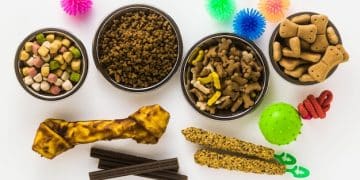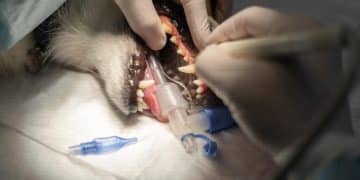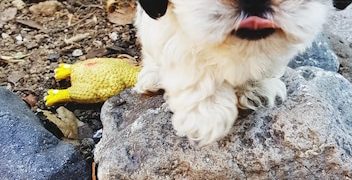Protect Your Pet’s Smile: A Daily Dental Health Routine

Dental disease in pets is a common problem that can lead to serious health issues; however, preventing tooth decay and gum disease can be achieved through a consistent daily dental care routine, including brushing, dental chews, and regular veterinary check-ups.
Is your furry friend’s breath a little too potent lately? Like humans, pets are susceptible to dental disease in pets, but preventing tooth decay and gum disease is possible with a consistent daily routine. Let’s explore how to keep your pet’s pearly whites shining and their oral health in tip-top shape.
Understanding Dental Disease in Pets
Dental disease is one of the most common health problems affecting dogs and cats. It’s not just about bad breath; it can lead to pain, tooth loss, and even affect your pet’s overall health. Understanding the stages and causes of dental disease is essential for prevention.
The Stages of Dental Disease
Dental disease progresses through several stages, starting with plaque and leading to more severe conditions if left untreated. Recognizing these stages can help you take action early.
- Gingivitis: This is the initial stage, characterized by inflammation of the gums. You might notice redness and swelling.
- Periodontitis: As the disease progresses, it affects the tissues and bone supporting the teeth, leading to pockets and potential tooth loss.
- Tartar buildup: Plaque hardens into tartar, which is more difficult to remove and harbors bacteria.
- Advanced Periodontal Disease: Severe damage to the tissues and bone, causing pain, infection, and systemic health issues.
Early detection is key to preventing the progression of dental disease. Regular check-ups and a proactive approach to oral hygiene can make a significant difference.
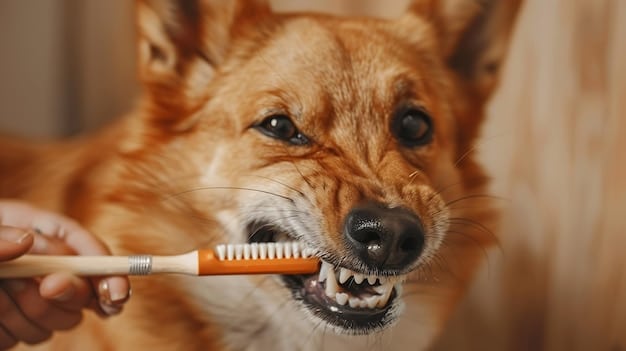
What Causes Dental Disease in Pets?
Several factors contribute to the development of dental disease in pets. Understanding these causes can help you take preventive measures.
Bacteria in the mouth combine with food particles to form plaque, a sticky film that adheres to the teeth. Over time, this plaque can harden into tartar, which is more difficult to remove. Certain breeds may be more prone to dental issues due to their teeth alignment, allowing more plaque to build-up. Diet can also be a contributing factor, with sugary and sticky foods promoting bacterial growth.
Genetics, age, and overall health also play a role. Regular dental care and professional cleanings are essential to combat these factors and maintain your pet’s oral health.
In conclusion, understanding the stages and causes of dental disease is the first step in preventing it. By being proactive and consistent with dental care, you can help your pet maintain a healthy and pain-free mouth.
The Importance of a Daily Dental Routine
A daily dental routine is the cornerstone of preventing dental disease in pets. Just like humans, consistent oral care can significantly reduce the risk of dental problems. Without a daily routine, plaque and tartar can quickly accumulate, leading to more serious issues.
Implementing a daily dental routine doesn’t have to be a daunting task. It can be incorporated into your pet’s regular schedule with a few simple steps.
Brushing your pet’s teeth daily is one of the most effective ways to remove plaque and prevent tartar buildup. Dental chews and toys can also play a role in maintaining oral hygiene, helping to scrape away plaque as your pet chews. Regular dental check-ups with your veterinarian are crucial for early detection and professional cleaning.
Brushing Your Pet’s Teeth: A Step-by-Step Guide
Brushing your pet’s teeth might seem challenging, but with patience and the right technique, it can become a routine part of your pet’s care. Start slowly and gradually introduce the toothbrush and toothpaste.
- Choose the right tools: Use a pet-specific toothbrush and toothpaste. Human toothpaste contains ingredients that can be harmful to pets.
- Introduce the toothpaste: Let your pet lick a small amount of toothpaste from your finger to get used to the taste.
- Start slowly: Gently rub the toothbrush along your pet’s teeth and gums for a few seconds. Gradually increase the time as your pet becomes more comfortable.
- Focus on the outside surfaces: These are the most prone to plaque and tartar buildup.
- Reward your pet: End each session with praise and a treat to make the experience positive.
Consistency is key. Aim to brush your pet’s teeth daily, even if it’s just for a minute or two. Over time, this routine will become easier for both you and your pet.
Benefits of Dental Chews and Toys
Dental chews and toys are valuable additions to your pet’s dental care routine. They can help reduce plaque and tartar buildup while providing mental stimulation.
Choose dental chews and toys that are specifically designed for dental health. Look for products with textured surfaces that help scrape away plaque as your pet chews. Avoid chews that are too hard, as they can damage your pet’s teeth. Supervise your pet while they chew to ensure they don’t swallow large pieces.
In conclusion, a daily dental routine is essential for preventing dental disease in pets. By incorporating brushing, dental chews, and regular check-ups, you can help your pet maintain a healthy mouth and overall well-being.
Choosing the Right Dental Products
Selecting the right dental products for your pet is vital for effective oral care. With so many options available, it’s important to choose products that are safe, effective, and appropriate for your pet’s needs. Reading labels, consulting with your veterinarian, and understanding the ingredients are key steps in making informed decisions.
Different types of dental products offer various benefits. Toothpastes formulated for pets help remove plaque and freshen breath, while dental chews and toys provide mechanical cleaning action. Selecting the right products involves researching ingredients and considering your pet’s preferences and dental condition.
When choosing dental products for your pet, consider their age, breed, and any existing health conditions. Always consult with your veterinarian to determine the best options for your pet’s specific needs.
Understanding Pet Toothpaste Ingredients
Pet toothpaste is specially formulated to be safe and effective for animals. Unlike human toothpaste, it does not contain fluoride or xylitol, which can be toxic to pets. Familiarize yourself with the common ingredients and their benefits.
- Enzymes: Help break down plaque and tartar.
- Abrasives: Gently scrub the teeth to remove debris.
- Flavorings: Make the toothpaste more palatable for pets.
- Antiseptics: Help kill bacteria in the mouth.
Always read the label and avoid products with artificial colors, flavors, or preservatives. Natural and organic options are often a safer choice for your pet.
Selecting Safe and Effective Dental Chews
Dental chews can be a great way to promote oral hygiene in pets, but it’s crucial to choose safe and effective options. Some chews can be too hard, posing a risk of tooth fractures, while others may contain harmful ingredients.
Opt for dental chews that are specifically designed for dental health. Look for products with the Veterinary Oral Health Council (VOHC) seal of acceptance. This seal indicates that the product has been tested and proven effective in reducing plaque and tartar.
In conclusion, choosing the right dental products is crucial for maintaining your pet’s oral health. By understanding the ingredients and benefits of different products, you can make informed decisions that support your pet’s dental care routine.
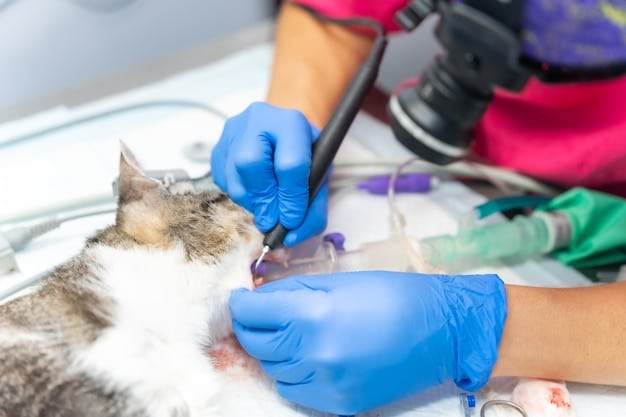
The Role of Professional Dental Cleanings
While a daily dental routine is vital, professional dental cleanings performed by a veterinarian are also crucial for maintaining your pet’s oral health. These cleanings go beyond what you can achieve at home and can detect and treat dental issues early on.
Professional cleanings involve scaling and polishing the teeth to remove plaque and tartar buildup. Your veterinarian will also examine your pet’s mouth for signs of dental disease, such as gingivitis, periodontitis, and tooth decay.
Determining the frequency of professional cleanings depends on your pet’s individual needs. Factors such as age, breed, diet, and overall health can influence how often your pet requires a dental cleaning.
What to Expect During a Professional Cleaning
Understanding what happens during a professional dental cleaning can help ease any concerns you may have about the procedure. The process typically involves anesthesia to ensure your pet’s safety and comfort.
Before the cleaning, your veterinarian will perform a physical exam and may recommend blood work to assess your pet’s overall health. During the cleaning, your pet will be under anesthesia while the veterinarian scales and polishes the teeth. After the cleaning, your veterinarian will provide you with instructions for at-home dental care.
How Often Should Your Pet Have a Dental Cleaning?
The frequency of professional dental cleanings varies depending on your pet’s individual needs. Some pets may only need a cleaning every one to two years, while others may require more frequent cleanings.
The best way to determine how often your pet should have a dental cleaning is to consult with your veterinarian. They can assess your pet’s oral health and recommend a cleaning schedule that is appropriate for their needs.
In conclusion, professional dental cleanings are an essential part of maintaining your pet’s oral health. By working with your veterinarian to develop a cleaning schedule, you can help prevent dental disease and ensure your pet’s overall well-being.
Recognizing Signs of Dental Problems
Early detection of dental problems can prevent more severe issues and ensure timely treatment. As a pet owner, being vigilant about changes in your pet’s behavior and oral health can make a significant difference. Recognizing the signs of dental problems allows you to seek veterinary care promptly.
Bad breath, also known as halitosis, is one of the most common signs of dental problems in pets. Other signs include excessive drooling, difficulty eating, and swollen or bleeding gums. Regular oral exams at home can help you spot these issues early.
Consulting your veterinarian if you notice any signs of dental problems is essential. Early treatment can save your pet from pain and prevent more severe complications.
Common Signs of Dental Disease
Several signs can indicate that your pet is experiencing dental problems. Being aware of these signs can help you take action and seek veterinary care as soon as possible.
- Bad breath: A persistent foul odor from the mouth.
- Excessive drooling: Increased saliva production, often stained with blood.
- Difficulty eating: Hesitation to eat, dropping food, or chewing on one side of the mouth.
- Swollen or bleeding gums: Red, inflamed gums that bleed easily when touched.
If you notice any of these signs, schedule an appointment with your veterinarian for a dental exam. Early intervention can help prevent the progression of dental disease.
Performing Regular Oral Exams at Home
Regular oral exams at home can help you monitor your pet’s oral health and detect any potential problems early on. Make it a part of your routine to check your pet’s mouth regularly.
Gently lift your pet’s lips and examine their teeth and gums. Look for signs of redness, swelling, bleeding, or tartar buildup. Check for any loose or broken teeth. If you notice anything unusual, consult with your veterinarian.
In conclusion, recognizing the signs of dental problems is crucial for preventing more severe issues. By being vigilant and proactive, you can help your pet maintain a healthy and pain-free mouth
Diet and Nutrition for Dental Health
Diet and nutrition play a significant role in your pet’s dental health. Certain foods can promote plaque and tartar buildup, while others can help keep your pet’s teeth clean and healthy. Choosing the right diet can support oral hygiene and overall well-being.
Dry food is generally better for dental health than wet food, as it helps to scrape away plaque as your pet chews. However, not all dry foods are created equal. Look for dental-specific diets that are designed to reduce plaque and tartar.
Certain supplements, such as those containing enzymes, can also help promote dental health. Consulting with your veterinarian about the best diet and supplements for your pet is essential.
The Impact of Food Texture on Dental Health
The texture of your pet’s food can significantly impact their dental health. Dry food, with its abrasive texture, can help scrape away plaque and tartar as your pet chews. This mechanical action helps keep the teeth clean and reduces the risk of dental disease.
Wet food, on the other hand, tends to stick to the teeth and can contribute to plaque buildup. If you feed your pet wet food, be sure to supplement with regular brushing and dental chews.
Supplements That Support Dental Health
Certain supplements can help promote dental health in pets. These supplements often contain enzymes that help break down plaque and tartar. They can be added to your pet’s food or given as a treat.
Some popular dental supplements include those containing probiotics, which help balance the bacteria in the mouth and promote a healthy oral microbiome. Always consult with your veterinarian before adding any supplements to your pet’s diet.
In conclusion, diet and nutrition are crucial for maintaining your pet’s dental health. By choosing the right foods and supplements, you can help prevent dental disease and ensure your pet’s overall well-being.
| Key Point | Brief Description |
|---|---|
| 🦷 Daily Brushing | Removes plaque, preventing tartar build-up. |
| 🦴 Dental Chews | Aids in scraping away plaque while chewing. |
| 🩺 Vet Check-ups | Ensures early detection and professional cleaning. |
| 🍎 Proper Diet | Dry food and dental diets support oral health. |
Frequently Asked Questions
▼
Dental health is linked to overall health. Dental disease can lead to pain, tooth loss, and systemic infections affecting organs like the heart and kidneys. Prevention ensures a healthier and happier pet.
▼
Ideally, you should brush your pet’s teeth daily. If daily brushing isn’t possible, aim for at least three times a week to help prevent plaque and tartar buildup effectively.
▼
Look for dental chews approved by the Veterinary Oral Health Council (VOHC). These chews are tested and proven to reduce plaque and tartar. Avoid chews that are too hard to protect your pet’s teeth.
▼
No, never use human toothpaste for pets. Human toothpaste contains ingredients like fluoride and xylitol, which are toxic to animals. Always use pet-specific toothpaste formulated for their safety.
▼
Ask your regular vet for a referral to a veterinary dentist. You can also search online directories for board-certified veterinary dentists in your area to ensure specialized care.
Conclusion
Maintaining your pet’s dental health is an integral part of their overall well-being. By implementing a daily dental routine, choosing the right products, and scheduling regular professional cleanings, you can prevent dental disease and ensure your furry friend enjoys a healthy and happy life.
